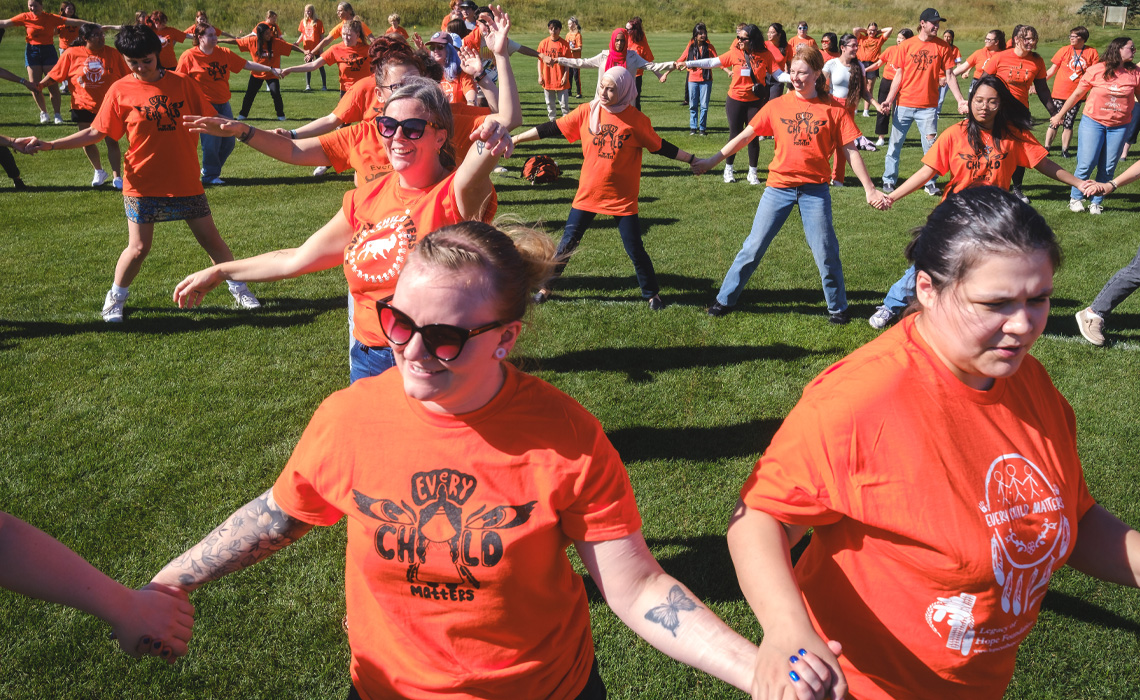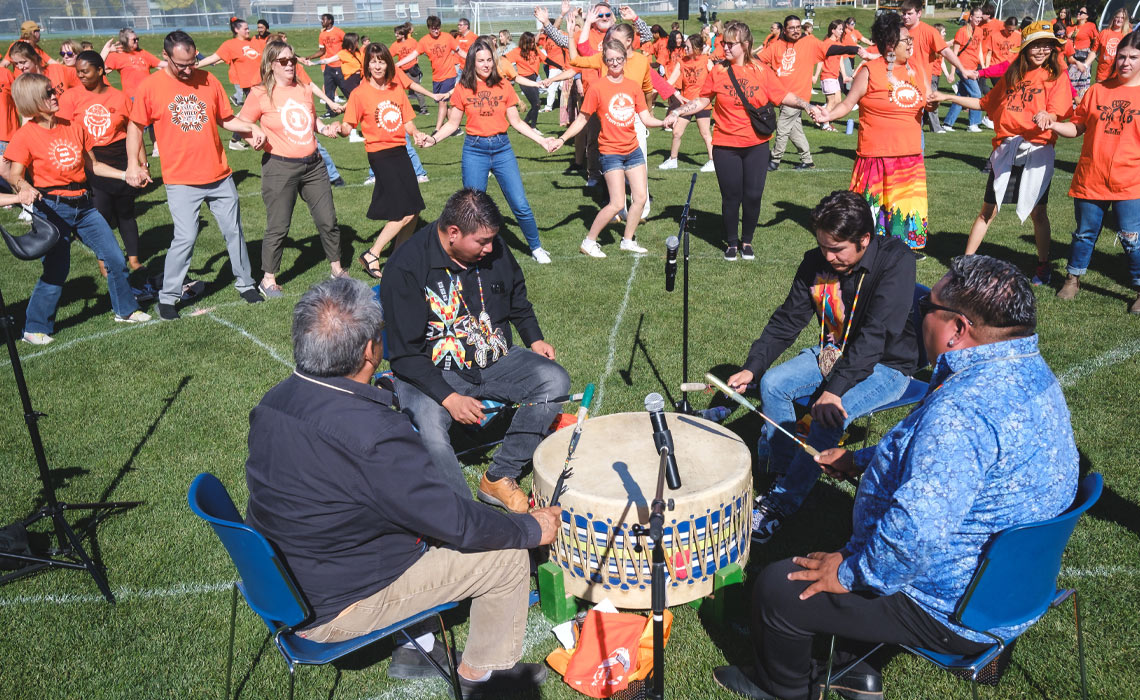Ani to pisi sparks awe of collective action

A simple story shared by an Elder has become something much larger than anyone at Mount Royal University first imagined. The “human spiderweb,” a living enactment of the Siksika creation story ani to pisi, is inspiring awe, strengthening relationships and spreading across schools and communities in Alberta.
What began as a single event has grown into a movement of learning, connection and collaboration rooted in Indigenous knowledge, supported by Mount Royal’s commitment to indigenization and now celebrated each year during MRU’s annual Journey to Indigenization.
The story of ani to pisi, the human spiderweb, comes from Siksika Elder Clement Bear Chief, who passed away in 2022. His younger brother, Roy Bear Chief — an Elder-in-residence and 2024 honorary doctor of laws recipient at MRU — brings the story to life every September. The event has grown to attract more than 500 students, faculty and community members who join hands to form a giant web. Drummers create the vibrations that travel across the web, sparking a powerful reminder of interconnection.
“It connects us all. It speaks to the idea that we all belong here, regardless of who we are. If there are problems anywhere on the web, it will vibrate. And if you feel those vibrations, you are supposed to go and help,” explains Bear Chief, who adds that good vibrations are celebrated too.
Growing its roots, ani to pisi has been shared and used to inform leadership at MRU and is a foundational component of the Faculty of Health, Community and Education’s strategic plan.
“It’s action-oriented,” says Dr. Stephen Price, PhD, the faculty’s dean. “People don’t just hear a story from an Elder and then move on. They participate. They feel the web vibrate. They get to experience what it means to be part of something bigger.”
Since that first enactment, the web has spread far beyond campus. Faculty, students, Bear Chief and Elder-In-residence for the Bissett School of Business Hayden Melting Tallow have brought the human spiderweb to schools across Alberta.
“I’ve lost track of the number of schools that have shown an interest,” Price says. “Teachers and administrators see the value. It gives them an opportunity to learn directly from an Elder, to bring Indigenous perspectives into the classroom and to experience the story in a new way.”
The response has been enthusiastic. Educators describe it as a rare chance to both learn and participate. Students leave with a lasting sense of wonder.
Spiderweb sparks healing research into awe
For Dr. Patricia Kostouros, PhD, a retired professor from the Department of Child Studies and Social Work, the human spiderweb also offers a chance to study the impact of awe on mental wellness.
Kostouros and MRU assistant professor Chelan McCallion have been looking at the work of authors who study mental wellness, particularly the notion of being “awestruck.” They had already been talking about doing research in this area with children and youth who are living outside of their homes. “We had written an article just about the idea of using the experience of being awestruck with children who have been traumatized,” Kostouros explains.
Then came the human spiderweb. “When we first did the enactment, we heard over and over how amazing it was,” Kostouros says. “One student even wrote an assignment about experiencing awe during the spiderweb. That’s when we thought we should test this.”
They decided to do a small pilot study. “We used a scale, put together a survey, got ethics approval and sent it out to people who may have participated,” she says. The results were striking — every single respondent reported experiencing all of the characteristics of being awestruck. “One hundred per cent of the people who responded to the survey said they felt all of the characteristics of being awestruck,” Kostouros says.

This pilot study became the basis for an article published with the Greater Good Science Center at UC Berkeley.
The researchers have now extended the study to look at collective effervescence. “Being awestruck is one thing but then being awestruck due to collective effervescence is another layer,” Kostouros says. “Collective effervescence is when you experience awe because you're part of a collective group that is actually causing something good to happen in the world.”
The findings also highlighted how the spiderweb fostered a sense of belonging. “The first year of ani to pisi, Mount Royal’s motto was ‘You belong here’,” Kostouros recalls. “Several people said they never really felt like they belonged at MRU until they took part in this event. That sense of belonging stayed with them months later.”
Kostouros also sees this research as a way to decolonize the approach to mental wellness. "Rather than a major intervention like a diagnosis or medication, the interventions in some cases can be something like being awestruck or practicing gratitude,” she explains. She believes that these interventions can shift a person's mental capacity in that moment. “If I'm walking around feeling depressed and I start thinking about being part of the human spiderweb, all of the bodily sensations that I had when I was awestruck will come back to me and it will automatically change what's happening in the chemistry of my body,” she says.
The researchers also found that people had savoured the experience, recalling it and the accompanying feelings even six months after. Kostouros and McCallion have repeated the research and are now finalizing an article to be submitted to a journal, likely the Canadian Journal of Native Education.
Building communities literally and figuratively
Mount Royal’s Academic Media team has played a key role in capturing the ani to pisi journey. What began as a one-time drone recording has grown into multiple short films documenting the spread of the web across communities.
“The media team really became part and parcel of the human spiderweb,” Price explains. “They saw how powerful it was and committed themselves to helping it grow.”
These films have been screened at community events and film nights, and a new feature-length piece is in development that explores both the web itself and the broader journey of learning about Treaty 7 Nations.
“The story of ani to pisi has changed the landscape of learning,” Bear Chief says.
The web has also drawn interest from unexpected audiences, including architects who design K to 12 schools. After experiencing the enactment, they asked deep questions about how Elders and faculty collaborate, what it means to build relationships and how those values might be reflected in school design.
For Price, those conversations highlight what makes the project special. “It’s not just about the activity itself,” he explains. “It’s about creating space for relationships, listening, going slowly and valuing teachings that have been here for thousands of years.”
Both Bear Chief and Melting Tallow continue to guide ani to pisi alongside MRU faculty and students. For everyone involved, there’s a shared sense that the work is only beginning.
“They see that we’ve made progress,” Price says. “But they also know we’re not done. This is a journey that we want to continue together.”
As the web spreads across classrooms, communities and professions, it carries with it the awe of story and the promise of deeper understanding.

